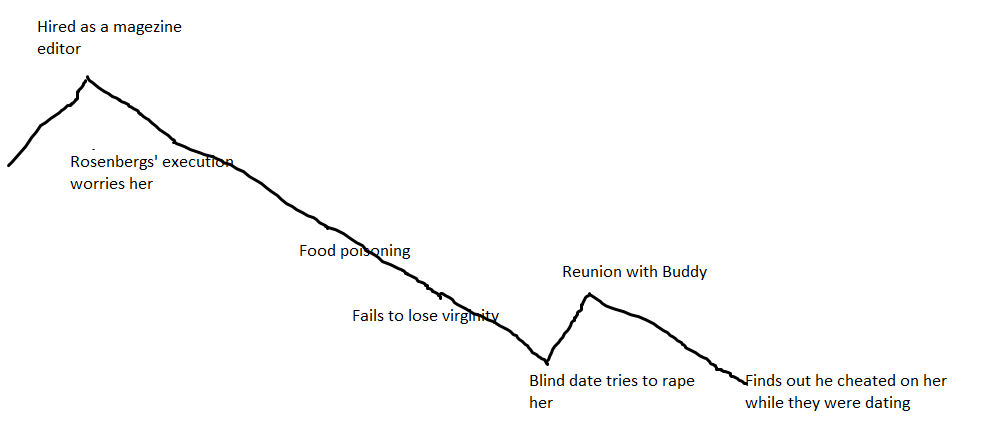When it comes to writing the second blog of the text, I noted how I mostly had to do a close reading. I am supposed to analyze the text closely and find surprising details about it that would not be expected of the genre.
With that, I am not only going to have to discover the genre for myself, but I am also going to have to closely analyze the text with the intent to bring more questions for myself, as I try to analyze the semic codes of the story.
The semic codes, according to Kaja Silverman, “always operates in close conjunction with cultural codes. Indeed, it is to a large degree an adjunct code, defining person and place in ideologically symptomatic ways” (Silverman, 253). I want to analyze the character Esther in Sylvia Plath’s The Bell Jar. I want to discover what her semic code is for myself and how I can use that to define the genre of the story for myself.
To get a better understanding of Esther and her semic code, I had decided to make a value graph, based on the major events of the story surrounding her so far.

Already, I have noticed a lot more negativity being highlighted in the events of her life than the positivity. At least, this is more of the trend that I have noticed as I have been reading the story. It is possible that I could have simply been focusing more on the negative events in her life than I have the positives. However, I tried to remain as objective as possible while trying to summarize her events so far. I think there could be a reason that the events of Esther’s life in the story is more negative than it is positive. I think it has to do with both the semic code and the genre.
So far, if I were to pin a genre to this story, I would say that it is realistic fiction. However, that genre is simply too broad to categorize this book, while it is realistic and fictional, there are themes that play into the story of Esther that aren’t found in every realistic fiction story. That theme is the state of her mental health, or rather the decline of it. Before that, she was a rather innocent individual, I would even say that she was naive. She has specific expectations for the world around her and she expects them to be met as if they were natural. One example of this was how she expects to skip chemistry. “I don’t know just why my successful evasion of chemistry should have floated into my mind there in Jay Cee’s office. All the time she talked to me, I saw Mr. Manzi standing on thin air in back of Jay Cee’s head […] and Mr. Manzi laugh. I felt sorry for Mr. Manzi. I felt like going down to him on my hands and knees and apologizing for being such an awful liar” (Plath 39). Professor Kopp actually discussed this along with the semic code before. Its a character type called an Ingenue. An Ingenue is described as a young, innocent, or unsophisticated girl in a play or a film.

This of course means that Esther will also have her innocence inevitably challenged, and that comes in the form of her second blind date. In terms of Esther at the beginning, she wanted to lose her virginity, however she wanted to lose it on her own terms. This however gets ripped away from her from a man named Marco. “‘Your dress!’ The mud oozed and adjusted itself to my shoulder blades. ‘Your dress!’ Marco’s face lowered cloudily over mine. A few drops of spit struck my lips. ‘Your dress is black and the dirt is black as well.’ Then he threw himself face down as if he would grind his body through me and into the mud” (Plath 109). This is the first time in her life where her life decisions are out of her control, and this is one of several moments that will mentally scar her for the rest of the story. This is important because not only does it reveal her next step as the Ingenue, but it also shows the reader what the semic code will be for the story.
Esther’s mental deterioration was the clear seme for her. It was hinted at around the beginning of the story. Esther already showed suicidal thoughts before her trauma from Marco happens. “The interior voice nagging me not to be a fool—to save my skin and take off my skis and walk down, camouflaged by the scrub pines bordering the slope—fled like a disconsolate mosquito. The thought that I might kill myself formed in my mind coolly as a tree or a flower” (Plath 98). While it is a part of her subconscious, it is still a part of her struggle with her mental health, and if the events of her life continue the downward trend into negativity, the suicidal thoughts will only get worse. At this moment, she was able to ignore it, and go skiing down the hill anyway. However, she won’t be so lucky later in the books.
She doesn’t successfully kill herself in the story, however she makes three suicide attempts. One might think that these are her lowest points, I believe it is a little bit after. People attempt to help her, however she wouldn’t want the help. “My mother told me I should be grateful. She said I had used up almost all her money and if it weren’t for Mrs. Guinea she didn’t know where I’d be. I knew where I’d be though. I’d be in the big state hospital in the country, cheek by jowl to this private place. I knew I should be grateful to Mrs. Guinea, only I couldn’t feel a thing” (Plath 185). The reason why I point this out is because I believe this is the best example of both her lost innocence and her mental degradation. She is following her seme as an Ingenue.

I started to wonder about the title of the book, what is a bell jar? Ironically, it is an experiment for when the air is sucked out of a jar that has a bell inside. The bell is ringing yet there is no sound coming out. I tried to see how this would pertain to Esther and I came to this; she is seemingly trapped within her own mental degradation. She can’t find someone who can understand her because no one around her has been through what she has been through. That is why she often argues with her mom and doctors and nurses. She doesn’t want to be helped, she wants to be understood. She wants the semic code to be known. At least that is how I interpret it. But I also want to take this discussion of the semic code even further, because I also started to notice a pattern not just with her, but with the other books I read in this class.
There seems to be an ongoing theme with the stories that my reading group has read through the semester. The decline in the mental health of the individual. In Slade House, Jonah and Norah use the weaknesses of their victims, the weaknesses in their mental state to manipulate them, and to trap them to extract their souls. Whether it was to create a friend in need, a lustful woman, or several other things in which they can “help” their victims.
Then there is Turtles All the Way Down, where the story focuses on Aza and her OCD, how she struggles to live with it and how she tries to connect to the rest of the world. It is the most defining character trait for her throughout the story.
I think there is a similar theme with Esther and her mental state. With the trauma she has experienced and the overall negative outlook through the perspective of the story, I think Esther’s own semic code is her inner voice.

I wanted to get a better understanding of how to analyze the semic code in the story, and to do that, I had to apply an analysis to myself as a reader. I found myself asking “what would be a seme for me?” Taking a closer look at the readings in our reading group this semester, in terms of me as a reader, I would have to say part of my personal semic code would be studying the struggles of mental illness. The reason why I feel this is because in today’s society, mental illness has become a widespread discussion and there has been a large amount of encouragement to further study the issue. Mental illness itself has a significant impact on my culture and me as an individual, after all, why else would we be reading so many books about it?
This is further emphasized by Silverman when the semic code is described to be paired with the cultural codes. “This code […] operates in tandem with the semic code to inscribe and re-inscribe a culturally determined position or group of positions to which the reader or viewer is expected to conform” (Silverman 260). Like Esther, there are many people who want to be understood. That is why the discussion of mental illness is so widespread in the first place.
There seems to be a hidden message behind our decisions, even in something as simple as what we choose to read. It defines our interests, our personalities, it defines who we are as people. Are we really following our desires, or is our decisions already predetermined for us? I cannot say for myself, but I believe that this is worth thinking about to better understand myself as a person.

I agree with Brendon that the semic code is Esther’s inner voice. It is interesting to see how Plath used the inner voice throughout the story. It was like the reader was distracted by the other things going on with Esther, like her dates, Buddy, etc. It feels like those situations meant to distract the reader from the real danger, which was Esther’s mental state. In a way, it showed how some people might not be able to notice when someone needs help. I also agree with the bell jar experiment, which was a bell inside a bell jar and a vacuum that sucked the air out of it, and when there was no air, then you could not hear the bell. That was Esther, as she wanted someone to understand her and what happened to her. That is why she argued or fought back against the treatment because all she wanted was to be understood. And ironically, the previous stories we read as a group dealt with mental illnesses too, and it is like we are going down the rabbit hole.
LikeLike
The semic code, when you really get into the world of it, is wonderful and just so cool to be in. Once you identify one seme, others seem to continue to pop-up around you. I can’t help but think of the fig tree story that Sierra talks about in the next blog. While it is also a way to showing the rhetoric of narrative, and how Esther is trapped and bound to the ideal narrative audience of the controlling value, that explanation starts with the semic code. So a Jewish man and a nun fall in love under a fig tree but know that their love is doomed. Then Esther projects that feeling of doom onto herself, why? Well, that starts with the fig and the fig tree. If you cut open a fig and were to add some semic meaning to it, they look quite like a womb. The couple in the story are doomed because of their religious differences that didn’t allow them the freedom to marry that we live in today, not to mention that the woman was a nun. She didn’t have the ability to marry, no matter the person’s religion. So the womb of this woman is doomed and dying since she won’t be able to reproduce with the person she fancies. Now let’s look at Esther. She is not bound by religion, but more so her sexuality. Her virginity looms over her like a threat and a reminder of all failed attempts at finding love and romance. And each fig begins to represent her failed attempts at finding a man to settle down with, a man to take her virginity, and a man to reproduce with. Her literal womb and figurative “romantic” womb are dying. But again, Esther is so bound by the dominant controlling value that she can’t see this story as anything but a dig at herself worth. She is reminded that she is “failing” and can’t see that her life and value extends beyond her sexuality.
LikeLike
I also agree with this semic code, the value graph shows how negatively impacted her life was. What blows my mind in a way is that some of these negative aspects aren’t that important. What I mean by that is that they shouldn’t be the things that really stress her out, like losing her virginity, Rosenberg execution. Her wanting to lose her virginity is like a power over her, she feels as if she has to get that done to be a women in their society, or to “fit in.” When you say “She has specific expectations for the world around her and she expects them to be met as if they were natural” really stands out. Because she has such high expectations, it’s almost as if she has a deadline she needs to get them done by. Her multiple attempts at commiting suicide were on how she should do it, but she never thought of why. But as her mental health takes over her life, we learn that she is stuck in a Bell Jar, I learn to understand that that’s what she feels like when she feels depressed. I really enjoyed that our books prior to this one all have some sort of connection, whether its with their mental health or the power that gets them to fall for something.
LikeLike